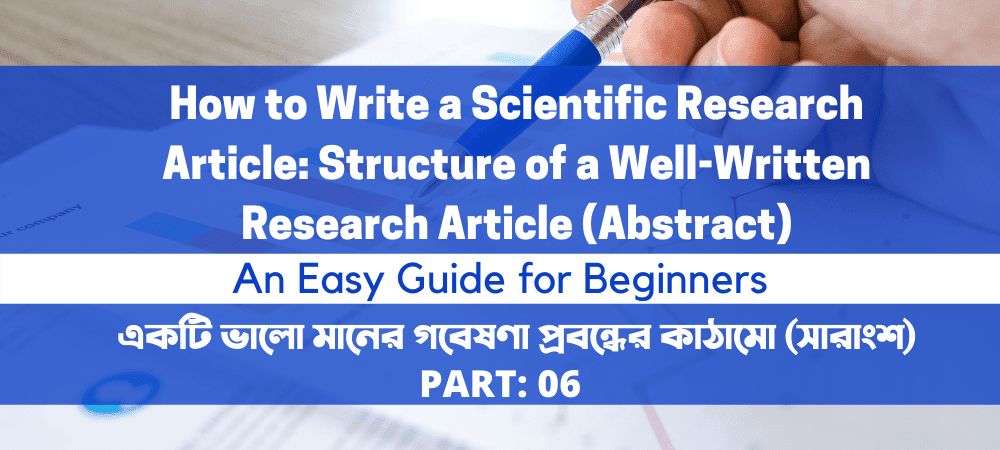[This article is bilingual in Bengali and English. Please scroll down this page to read it in English.]
কীভাবে একটি বৈজ্ঞানিক গবেষণা প্রবন্ধ লিখতে হয়
(পর্ব ৬)
একটি ভালো মানের গবেষণা প্রবন্ধের কাঠামো
শিরোনামের পর একটি গবেষণা প্রবন্ধের যে বিষয়টি সবচেয়ে গুরুত্বপূর্ণ এবং পাঠকরা গুরুত্বের সাথে দেখে তা হলো- সারাংশ।
২. সারাংশ
সারাংশ হল আপনার গবেষণা কাজের সারসংক্ষেপ। সাধারণত দৈর্ঘ্যে এটি একটি অনুচ্ছেদের চেয়ে কম হয় (৬-৭টি বাক্য, ১৫০-২৫০টি শব্দ)। একটি ভাল মানের সারাংশ কতিপয় বিষয়গুলো পুরণ করেঃ
- এটি আপনার পাঠকদের দ্রুত সিদ্ধান্ত নিতে সাহায্য করে যে তারা আপনার পত্র বা প্রবন্ধটি সম্পূর্ণ পড়বে কিনা।
- এটি পাঠকদের আপনার সম্পূর্ণ পেপারের বিস্তারিত তথ্য, বিশ্লেষণ এবং যুক্তি অনুসরণ করতে মানসিকভাবে প্রস্তুত করে।
- এটি পাঠকদের আপনার পেপারের মূল বিষয়গুলোও মনে রাখতে সহায়তা করে।
এছাড়াও এটি মনে রাখা দরকার যে সার্চ ইঞ্জিন এবং গ্রন্থের উপাত্ত আপনার গবেষণার শিরোনাম ছাড়াও সারাংশ ব্যবহার করে আপনার প্রকাশিত প্রবন্ধের সূচিকরণ নির্ধারণ করে। সুতরাং, আপনার পত্র বা প্রবন্ধের সারাংশ এবং শিরোনাম অন্যান্য গবেষকদেরকে আপনার পত্র বা প্রবন্ধটি সনাক্ত করতে সহায়তা করার জন্য বেশ গুরুত্বপূর্ণ।
একটি ভালো মানের সারাংশে যে বিষয়গুলো থাকেঃ
- আপনার গবেষণার জন্য কাঠামো বা পটভূমি; বিবেচনাধীন বিস্তৃত সমস্যা; আপনার তদন্তের বিষয়টি।
- আপনার গবেষণায় উল্লেখ করা সমস্যাটি নিয়ে প্রয়োজনীয় প্রশ্ন বা বিবৃতি।
- এই বিষয় নিয়ে ইতিমধ্যেই কি জানা আছে, পূর্বে করা গবেষণায় কি প্রমাণ করা হয়েছে।
- প্রধান কারণ (গুলি), প্রয়োজনীয়তা, যুক্তি, গবেষণার লক্ষ্য- এই প্রশ্নের উত্তর দেওয়া কেন গুরুত্বপূর্ণ? উদাহরণস্বরূপ আপনি একটি নতুন বিষয় নিয়ে গবেষণা করছেন। কেন এই বিষয়টি তদন্তের যোগ্য? আপনি কি পূর্ববর্তী গবেষণার শূন্যস্থান পূরণ করছেন? নতুন পদ্ধতি ব্যবহার করে পুরাতন ধারণা এবং তথ্যকে কি নতুনভাবে উপস্থাপন করছেন? ওই বিষয়টির কোন মতবিরোধটি সমাধান করছেন?
- আপনার গবেষণা এবং বিশ্লেষণমূলক পদ্ধতি।
- আপনার মূল অনুসন্ধান, ফলাফল বা যুক্তি।
- আপনার অনুসন্ধান বা যুক্তিগুলোর প্রাসঙ্গিকতা বা প্রভাব।
সারাংশ যেহেতু আপনার গবেষণা প্রবন্ধের সারসংক্ষেপ, তাহলে চলুন কিভাবে একটি ভাল সারাংশ লিখতে হয় তা শিখি।
ভালো-মানের সারাংশের বৈশিষ্ট্য
- সারাংশটি দৈর্ঘ্যে ১৫০ থেকে ২৫০ শব্দের হবে।
- একটি সারাংশ এমন হতে হবে যেন পাঠকরা পড়া মাত্রই গবেষনাপ্ত্রে কি রয়েছে তা সম্পর্কে স্পষ্ট ধারণা লাভ করতে পারে।
- সারাংশটি সরল ভাষায় সংক্ষিপ্ত হওয়া উচিত এবং এতে অস্পষ্ট শব্দ এবং জটিল বাক্যের ব্যবহার পরিহার করা উচিত এবং এতে যেন পাঠকের পড়া এবং বোঝার জন্য পর্যাপ্ত তথ্য উপস্থিত থাকে।
- সারাংশটি এমনভাবে লেখা উচিত যাতে এটি পাঠকের কাছে একটি ছোট গল্পের মতো মনে হয় এবং এমনভাবে উপস্থাপন করা উচিৎ যেন তিনি পুরো প্রবন্ধটি পড়তে বাধ্য হন। অপ্রাসঙ্গিক শব্দ বা বাক্য অনুমোদিত নয়।
- সারাংশে কোনো ব্যাকরণগত ত্রুটির সুযোগ নেই। সুতরাং, আপনি সারাংশটি লেখার পর ত্রুটিমুক্ত করার জন্য বিশেষজ্ঞ গবেষক অথবা বানান ও ব্যাকরণ বিশেষজ্ঞের সাহায্যে কয়েকবার শুদ্ধতা যাচাই করুন।
কীভাবে সারাংশ লেখা উচিত?
সারাংশ মূলত একটি প্রচারণা (মার্কেটিং) কৌশল এবং এর মান নির্ধারণ হবে পাঠক এটি পড়ার পর সম্পূর্ণ পত্রটি পড়ার আগ্রহ পাচ্ছে কি পাচ্ছে না তার উপর।
নির্দিষ্ট নিয়ম অনুসরণ করার মাধ্যমে গবেষণাপত্র বা, রিসার্চ পেপারের জন্য ভালো মানের সারাংশ রচনা করা বেশ সহজ। এটি নিম্নে ব্যাখ্যা করা হলোঃ
ক. পটভূমির ভূমিকা (২ থেকে ৩ বাক্যের মধ্যে)
- আপনি কেন গবেষণার জন্য এই বিষয়টি নির্বাচন করেছেন? এই বিষয়টি নির্বাচন করার ক্ষেত্রে কি আপনাকে অনুপ্রেরণা যুগিয়েছে?
- আপনার গবেষণাটির তাৎপর্য কি?
- আপনার গবেষণাটি উক্ত বিষয়ে কী প্রভাব ফেলবে বা কী নতুনত্ব আনয়ন করবে?
- এই প্রশ্নের উত্তরগুলো ২ থেকে ৩ বাক্যে সাজান।
খ. সমস্যা এবং উদ্দেশ্য (১ থেকে ২ বাক্যের মধ্যে)
- পূর্ববর্তী গবেষকদের গবেষণাগুলোর ব্যর্থতাগুলো তুলে ধরুন, যারা কিনা তাদের গবেষণায় নির্দিষ্ট কিছু চ্যালেঞ্জ মোকাবেলা করতে সক্ষম হয়নি।
- আপনার এই প্রবন্ধের লক্ষ্য উল্লেখ করুন, যেমনঃ উক্ত সমস্যাটির সমাধান করা।
গ. পদ্ধতি সমূহ (১ থেকে ২ বাক্যের মধ্যে)
- গবেষণায় চ্যালেঞ্জ মোকাবেলার জন্য আপনি কি কি পদ্ধতি ব্যবহার করেছেন তার একটি সাধারণ পর্যালোচনা লিখুন।
- এখানে পদ্ধতিগুলোকে বিস্তারিত ব্যাখ্যা করার প্রয়োজন নেই কেননা এগুলো পদ্ধতিসমূহ বিভাগে ব্যাখ্যা করা হয়েছে।
ঘ. ফলাফল (১ থেকে ২ বাক্যের মধ্যে)
- গবেষণা থেকে প্রাপ্ত উল্লেখযোগ্য ফলাফলগুলোকে সংক্ষিপ্তভাবে উল্লেখ করুন।
- সবথেকে গুরুত্বপূর্ণ তথ্য ক্রমানুসারে উল্লেখ করুন।
- পাঠককে আপনার গবেষণা থেকে প্রাপ্ত ফলাফলের প্রতি আশাবাদী করে তুলুন।
- সমালোচনা (আলোচনা) বিভাগে প্রদত্ত তথ্য ও ফলাফল নিয়ে বিতর্ক করার প্রয়োজন নেই।
ঙ. উপসংহার এবং গুরুত্ব (২ বাক্যে)
- উক্ত সমস্যাটিতে আপনার প্রতিক্রিয়া বা মতামত কি? আপনার গবেষণাটিকে এমনভাবে উপস্থাপন করুন যেন পাঠক বুঝতে পারে যে সমস্যাটির সমাধান হয়েছে।
- আপনার গবেষণা কিভাবে এই বিষয়ের অন্য গবেষকদের জন্য লাভজনক হবে? সারাংশের শেষে, একবাক্যে এর ব্যবহারের সুযোগ নির্দেশ করুন।
কখন সারাংশটি লিখবেন?
যেহেতু সারাংশটি আপনার রিসার্চ পেপারের প্রথমে থাকবে তাই সারাংশটি প্রথম পর্যায়ে লিখতে মন চাইবে, কিন্তু আপনার উচিত হবে সম্পূর্ণ গবেষণাপত্রটি লেখা শেষ করা পর্যন্ত অপেক্ষা করা। কেননা গবেষণাপত্রটি সম্পন্ন করার পর আপনি কি নিয়ে সারাংশ লিখছেন তা সম্পর্কে সম্পূর্ণ অবগত থাকবেন। এটি আপনার সারাংশকে সুন্দরভাবে উপস্থাপন করতে সহায়তা করবে।
English Version:
Structure of a well-written research article
After the title, the most important part of a research article that readers take seriously is the abstract.
2. Abstract
An abstract is a concise summary of your research work (published or unpublished), typically less than a paragraph in length (6-7 sentences, 150-250 words). A well-written abstract serves several functions:
- It allows readers to quickly grasp the gist or essence of your paper or article to decide whether to read the entire paper.
- It prepares readers to follow the detailed information, analyses, and arguments in your full paper.
- It also aids readers in remembering key points from your paper.
Additionally, it’s critical to keep in mind that search engines and bibliographic databases use abstracts in addition to the title to determine key terms for indexing your published article. Thus, the abstract and title of your paper or article are crucial for assisting other researchers in locating your paper or article.
A well written abstract contains the following:
- The framework or background material for your research; the broad issue under consideration; the exact subject of your investigation.
- The essential questions or statements of the problem addressed by your research.
- What is known about this subject already, what past research has been done or proven.
- The major reason(s), the urgency, the reasoning, the aims for your research—Why is it vital to answer these questions? Are you, for example, researching a new subject? Why is that a topic worth investigating? Are you filling a void left by prior research? Using new methods to look at old ideas or data in new ways? Resolving a disagreement in your field’s literature?
- Your research and/or analytical methodologies.
- Your key findings, results, or arguments.
- The relevance or ramifications of your findings or arguments.
Now, since your abstract is a brief summary of your research article, let’s learn how to write a good summary.
Features of a good abstract
- The abstract length should be between 150 and 250 words.
- A typical summary must be unique for a reader to obtain a sense of the thesis paper only by reading the summary.
- The essence should be summarized in plain terms, without employing obscure words or complex sentences, so that a reader has enough information to read and understand.
- The abstract should be written in such a way that it feels like a short story to the reader and presented in such a way that he is compelled to read the entire article. Irrelevant words or sentences are not permitted.
- In the abstract, no grammatical or spelling errors are permitted. So, once you’ve finished writing, you should double-check it with spelling and grammatical checkers or an experienced researcher.
How should an abstract be written?
The abstract is essentially a marketing technique, the quality of which will be determined by whether the reader continues to read the paper or loses interest here.
Following specific rules, it is easy to construct a high-quality abstract for a research or thesis paper. It is explained further below:
a. Introduction to the Background (in 2-3 sentences)
- Why did you choose this particular study topic? What was the driving force behind this?
- What is the significance of your research?
- What impact will the study have?
- Arrange the responses into 2-3 sentences.
b. Issues and objectives (in 1-2 sentences)
- Mention the research gaps of previous researchers who were unable to tackle the challenge(s).
- Mention the goal of your article, i.e., the solution to the problem.
c. Techniques (in 1-2 sentences)
- Make a general review of the methods you utilized in your research to tackle the challenge.
- There is no need to describe those approaches in detail as they are described in the Methodology section.
d. End result (in 2-3 sentences)
- Summarize the significant findings.
- Sort the most important information
- Allow the reader to be hopeful about the findings of your study.
- There is no need to debate any of the outcomes provided in this section’s discussion (discussion) section.
e. Conclusion and Importance (in 2 sentences)
- What is your response/opinion on the issue? Describe your study in such a way that the reader understands that it has solved the targeted problem.
- How will your research be valuable to other researchers in your field? At the end of the summary, indicate the scope of its use in another sentence.
When should you write the abstract?
It’s tempting to write your abstract initially because it will appear as the first portion of your paper, but waiting until after you have finished writing your entire paper will guarantee that you fully comprehend what you are summarizing.


